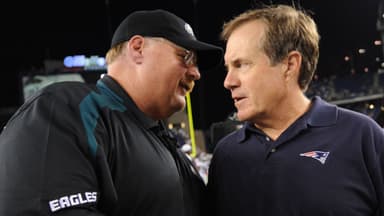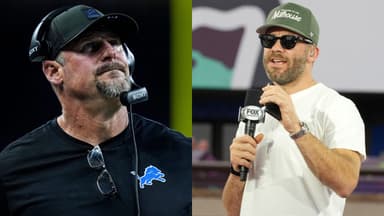For most, rule changes and player fitness levels are hallmarks of the ‘modern’ era of the NFL. But for Rob Gronkowski, these aren’t the only significant changes that have taken place recently. The legendary Patriots TE has also noticed a major shift in how NFL coaches look and present themselves.
Advertisement
Gone are the days when coaches like Bill Belichick would wear the same old hoodie every day, with their focus entirely on the field. Today, coaches like Sean McVay and Dan Campbell are tacticians who look like athletes… and present themselves to the media as such.
And funnily enough, Gronk isn’t a fan of this change.
“These coaches are starting to get in shape now… they’re looking slim, looking jacked… we need coaches to get fat again. I think the problem is that Ozempic came out,” Rob Gronkowski hilariously complained on Dudes on Dudes earlier this year.
His former teammate and podcast co-host Julian Edelman chimed in, half-joking that, “We got to start testing” these fit coaches for substance use. Gronk, in response, upped the ante, calling fitness almost a PED: “It should be on the PED list for these coaches… we need them fat again. It makes football better.”
View this post on Instagram
On its surface, it’s playful trash talk. But beneath it lies a commentary on shifting norms in NFL coaching culture, where once the largest man in the booth was seen as the unofficial benchmark of status. But now, coaches resemble athletes more than mentors.
That shift can be traced directly to the Sean McVay Effect.
McVay took over the Rams in 2017 at age 30 and quickly propelled the club to a Super Bowl in his second season. As it turned out, this success cracked open the door for a wave of sub-50 head coach hires.
USA TODAY Sports research shows that the average NFL head coach age has dropped from 53.4 in 2015 to 47.7 in 2025, the youngest in a quarter-century.
Owners are now hunting for younger, offensive-minded innovators across the league. Reportedly, nearly 40% of hiring cycles since 2017 have gone to coaches in their 30s, a stark contrast to the pre-McVay era.
Assistants in their 20s are now filling coordinator roles to coaches with Disney-esque lean physiques, partly due to age and partly to fit seamlessly into player-centric ecosystems.
Yet, that evolution brings trade-offs. As Rob Gronkowski pointed out with theatrical flair, part of the romance of football used to be larger-than-life personalities, coaches who looked like accountants, not athletes, and embodied stability for a fractured locker room.
Former player-turned-analyst Herm Edwards once summed this up well: “You needed to… bounce around a couple times until you’re hardened.” So Gronk’s nostalgia isn’t just about size for size’s sake; it’s also an appeal for character and presence amid sanitized professionalism.
That said, data, however, suggests that youth doesn’t guarantee wins. In fact, coaches under 50 carry a .504 winning percentage, nearly identical to those older — something we saw this year when 44-year-old Nick Sirianni contested against the 67-year-old Andy Reid at the Super Bowl.
So when Gronk rallies for the return of “fat coaching,” he’s throwing shade at progress and nostalgia for substance. It’s a reminder that innovation doesn’t automatically bring gravitas, and that big screens may look modern, but sometimes all we miss is a booming voice with too much pizza in his belly.







